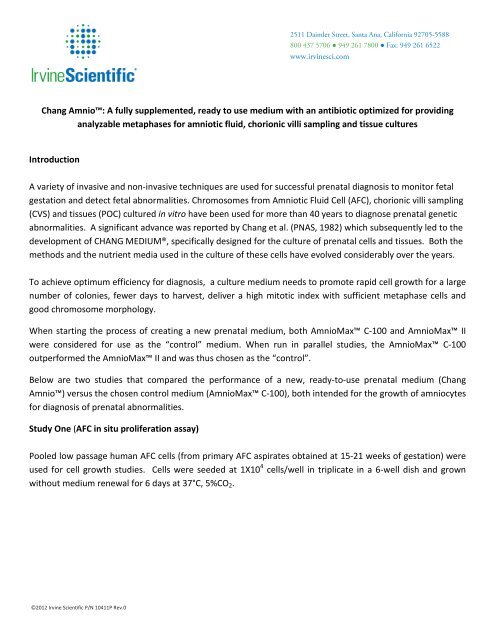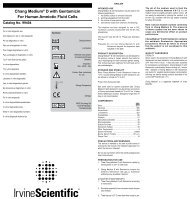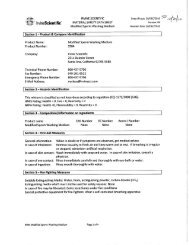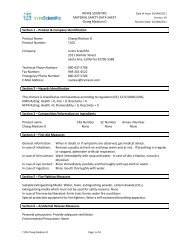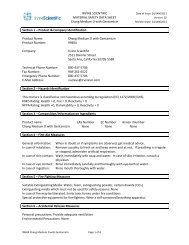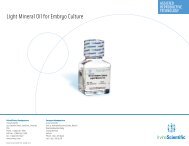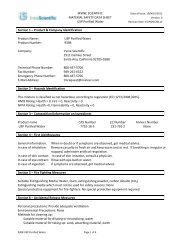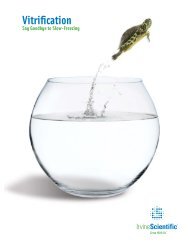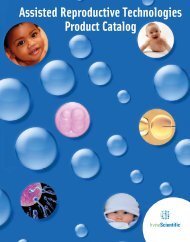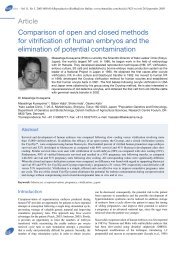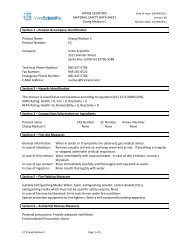Chang Amnio™: A fully supplemented, ready to ... - Irvine Scientific
Chang Amnio™: A fully supplemented, ready to ... - Irvine Scientific
Chang Amnio™: A fully supplemented, ready to ... - Irvine Scientific
You also want an ePaper? Increase the reach of your titles
YUMPU automatically turns print PDFs into web optimized ePapers that Google loves.
2511 Daimler Street, Santa Ana, California 92705-5588<br />
800 437 5706 ● 949 261 7800 ● Fax: 949 261 6522<br />
www.irvinesci.com<br />
<strong>Chang</strong> Amnio: A <strong>fully</strong> <strong>supplemented</strong>, <strong>ready</strong> <strong>to</strong> use medium with an antibiotic optimized for providing<br />
analyzable metaphases for amniotic fluid, chorionic villi sampling and tissue cultures<br />
Introduction<br />
A variety of invasive and non-invasive techniques are used for successful prenatal diagnosis <strong>to</strong> moni<strong>to</strong>r fetal<br />
gestation and detect fetal abnormalities. Chromosomes from Amniotic Fluid Cell (AFC), chorionic villi sampling<br />
(CVS) and tissues (POC) cultured in vitro have been used for more than 40 years <strong>to</strong> diagnose prenatal genetic<br />
abnormalities. A significant advance was reported by <strong>Chang</strong> et al. (PNAS, 1982) which subsequently led <strong>to</strong> the<br />
development of CHANG MEDIUM®, specifically designed for the culture of prenatal cells and tissues. Both the<br />
methods and the nutrient media used in the culture of these cells have evolved considerably over the years.<br />
To achieve optimum efficiency for diagnosis, a culture medium needs <strong>to</strong> promote rapid cell growth for a large<br />
number of colonies, fewer days <strong>to</strong> harvest, deliver a high mi<strong>to</strong>tic index with sufficient metaphase cells and<br />
good chromosome morphology.<br />
When starting the process of creating a new prenatal medium, both AmnioMax C-100 and AmnioMax II<br />
were considered for use as the “control” medium. When run in parallel studies, the AmnioMax C-100<br />
outperformed the AmnioMax II and was thus chosen as the “control”.<br />
Below are two studies that compared the performance of a new, <strong>ready</strong>-<strong>to</strong>-use prenatal medium (<strong>Chang</strong><br />
Amnio) versus the chosen control medium (AmnioMax C-100), both intended for the growth of amniocytes<br />
for diagnosis of prenatal abnormalities.<br />
Study One (AFC in situ proliferation assay)<br />
Pooled low passage human AFC cells (from primary AFC aspirates obtained at 15-21 weeks of gestation) were<br />
used for cell growth studies. Cells were seeded at 1X10 4 cells/well in triplicate in a 6-well dish and grown<br />
without medium renewal for 6 days at 37°C, 5%CO 2 .<br />
©2012 <strong>Irvine</strong> <strong>Scientific</strong> P/N 10411P Rev.0
2511 Daimler Street, Santa Ana, California 92705-5588<br />
800 437 5706 ● 949 261 7800 ● Fax: 949 261 6522<br />
www.irvinesci.com<br />
Results<br />
The growth performance of <strong>Chang</strong> Amnio was superior for AFC compared <strong>to</strong> AmnioMaxC-100 and<br />
AmnioMax II<br />
(Figure 1).<br />
x 1.0 E6 cell/well<br />
1.10<br />
1.00<br />
0.90<br />
0.80<br />
0.70<br />
0.60<br />
0.50<br />
0.40<br />
0.30<br />
0.20<br />
0.10<br />
0.00<br />
AFC cell growth after a 6 day culture<br />
<strong>Chang</strong> Amnio Amniomax C-100 Amniomax II<br />
Figure 1: AFC growth after 6 day culture in <strong>Chang</strong> Amnio and AmnioMax (initial inoculation 1.23xE04/well). The results are the<br />
average of 3 separate experiments + SEM.<br />
Study Two (Clinical evaluation)<br />
The clinical evaluation of <strong>Chang</strong> Amnio was carried out by an independent clinical Labora<strong>to</strong>ry (Colorado<br />
Genetics Labora<strong>to</strong>ry) using their standard amniotic fluid cell pro<strong>to</strong>col. Human amniotic fluid cell (AFC) samples<br />
from sixty (60) patients of gestational age between 15 and 21 weeks were used in parallel studies of medium<br />
performance. Each patient sample was split in<strong>to</strong> two tubes and centrifuged at 800-1000 rpm for 10 minutes in<br />
a clinical centrifuge. The supernatants were aspirated, and the two cell pellets were resuspended with 1 mL of<br />
medium per tube. In each case, one tube was resuspended with <strong>Chang</strong> Amnio and the other tube was<br />
resuspended with AmnioMAX C-100 (Gibco). A <strong>to</strong>tal of four 22 mm² sterile coverslips were seeded with 0.5<br />
mL of cell suspension each (two coverslips for each type of medium). Each pair of coverslips was maintained<br />
in a 35 mm² petri dish in a 37°C incuba<strong>to</strong>r at 100% relative humidity and 5% CO 2 . After approximately 24<br />
hours, 1 mL of the corresponding medium was added <strong>to</strong> each petri dish. After 3-4 days culture, the medium<br />
was changed each 2-3 days until harvest. On the day of harvest, Colcemid® was added for 35 minutes prior <strong>to</strong><br />
initiating the standard cell harvest and staining procedures.<br />
©2012 <strong>Irvine</strong> <strong>Scientific</strong> P/N 10411P Rev.0
2511 Daimler Street, Santa Ana, California 92705-5588<br />
800 437 5706 ● 949 261 7800 ● Fax: 949 261 6522<br />
www.irvinesci.com<br />
The clinical evaluations of the coverslips included 3 parameters that the clinical cy<strong>to</strong>genetics labora<strong>to</strong>ry judged<br />
<strong>to</strong> be most useful in a evaluation of the quality of a culture medium for cy<strong>to</strong>genetic analysis, namely:<br />
1. Days <strong>to</strong> Harvest<br />
2. The <strong>to</strong>tal number of colonies containing at least 50 cells per colony<br />
3. The number of mi<strong>to</strong>tic figures (metaphase spreads) per coverslip which meet the criteria for analysis<br />
Results<br />
The number of days <strong>to</strong> harvest varied between 6-8 days, depending on the quality of the specimen. The mean<br />
number of days <strong>to</strong> harvest was approximately 8 for each of the two of media, with no significant difference<br />
between them. <strong>Chang</strong> Amnio was comparable <strong>to</strong> AmnioMax C-100 for the average colonies per coverslip<br />
and mi<strong>to</strong>tic figures per coverslip.<br />
10<br />
Days <strong>to</strong> Harvest<br />
Colonies per<br />
coverslip<br />
Mi<strong>to</strong>ses per<br />
coverslip<br />
8<br />
12<br />
6<br />
4<br />
10<br />
8<br />
6<br />
30<br />
20<br />
2<br />
4<br />
2<br />
10<br />
0<br />
<strong>Chang</strong> Amnio<br />
Amniomax<br />
0<br />
<strong>Chang</strong> Amnio Amniomax<br />
0<br />
<strong>Chang</strong> Amnio Amniomax<br />
Figure 2: Performance of <strong>Chang</strong> Amnio: Clinical analysis of primary AFC samples from 60 patients were evaluated in parallel<br />
in 3 different lots of <strong>Chang</strong> Amnio compared <strong>to</strong> AmnioMax C-100. The results reported here are the mean value for n=60.<br />
Conclusion<br />
<strong>Chang</strong> Amnio is a new, high performing complete medium designed and optimized for providing analyzable<br />
metaphases for amniotic fluid, chorionic villi sampling and tissue (POC) cultures. It provides a reliable and<br />
consistent number of mi<strong>to</strong>tic cells suitable for karyotyping for more accurate cy<strong>to</strong>genetic analysis. <strong>Chang</strong><br />
Amnio is an excellent medium <strong>to</strong> choose when culturing prenatal cells.<br />
©2012 <strong>Irvine</strong> <strong>Scientific</strong> P/N 10411P Rev.0


